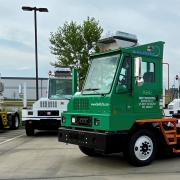Electric, CNG vehicles fuel Lawrence’s drive toward alt-fuels
Electric, CNG vehicles fuel Lawrence’s drive toward alt-fuels
By Jerry LaMartina
Metropolitan Energy Center, freelance writer
The City of Lawrence, Kansas has taken actions for many years to protect the environment, including putting alternative-fuel vehicles into use.
In October, the city put into service a refuse truck fueled by compressed natural gas (CNG), with help from a U.S. Department of Energy (DOE) Clean Cities grant of about $100,000. That money was part of an overall $15 million Clean Cities grant, awarded in December 2009, which also benefited several other municipalities, companies and others in the Kansas City area and elsewhere that had implemented alternative-fuels projects.
Kansas City-based Metropolitan Energy Center (MEC) administered the entire grant through a contract with the DOE. All the projects supported by the grant constitute MEC’s Midwest Region Alternative Fuels Project.
This is the city’s first and only dedicated CNG truck, says Steve Stewart, Lawrence’s fleet manager. The grant would only fund dedicated vehicles. The city also has a bi-fuel F-150 pickup, which is its first CNG vehicle. Bi-fuel vehicles are capable of running on more than one fuel but only on one at a time.
The truck cost just over $185,000, Stewart says. The grant provided $50,000, and the city paid the roughly $135,000 remainder. The grant required that the vehicle use a dedicated fuel – in this case CNG – Stewart says.
The Clean Cities grant also paid for 50 percent of the roughly $99,000 cost of a CNG fueling station the city installed. This is Lawrence’s first CNG station.
The city said in its project report to Clean Cities that it had chosen to deploy the CNG truck to evaluate whether the alternative fuel would meet its needs and save it money in the long run.
“So far the truck is meeting our needs, and I anticipate a return on investment of the CNG package within the seven-year life projection of the truck,” Stewart says. “ROI on the fuel station my take longer. As with anything new or different, people are slow to embrace change. The driver is adapting to the difference in the vehicle and learning to accept it.”
The grant also helped Lawrence put into use an electric vehicle called a club-car carryall, Stewart says. It looks like a golf cart but has an enclosed cab and a pickup bed. Maintenance crews at the city’s wastewater plant use it to haul their tools and supplies during service calls.
“We had put a similar electric vehicle into use, but we couldn’t haul equipment with it,” Stewart says. “So we used the grant to help us replace a full-size Ford Crown Victoria to haul equipment. Terms of grant were that you had to replace a full-size gasoline powered vehicle with the electric vehicle. It worked out really well, to the point that we’re about to replace another vehicle with another electric.”
The city paid $9,000 toward the vehicle’s cost, and the grant kicked in $2,000.
Those dollars always have to be considered – unless maybe you’re Bill Gates or Warren Buffet or somebody they play bridge with.
“Fifteen years ago, we couldn’t get grant money to do some of this alt-fuel implementation,” Stewart says. “We try to stay in touch with alternative fuels and do what we can. Until this grant came along, we haven’t had the money to do some of this stuff.”
Some of that includes plans to use two other CNG trucks to water trees on city property, which will start in the summer, he says. The water will come from a former fertilizer plant, which has nitrogen-rich water in containment ponds and which the city is remediating in conjunction with the Environmental Protection Agency. The city must contain the water to keep it from flowing back into groundwater. The city also provides the water to farmers in the area for use on their crops.
That water will help those crops grow, and Stewart wants to see alt-fuels use to grow, as well. While that growth embraces the practical value of alt-fuel vehicles – they decrease air pollution and other environmental damage wrought by resource extraction, they typically decrease fuel costs, they decrease dependency on foreign energy supplies – Stewart emphasizes the practical need to think through the financials.
“My biggest concern with it would be planning your budget for your infrastructure and the vehicles that you need, and then scheduling to give yourself enough lead time so you can get done what you need to,” he says.
While he keeps his eye on the budget, he also turns it toward the future.
“I’d like to see these efforts move forward after I retire,” Stewart says.
* * *
lamartina.jerry@gmail.com


 Photo by: Anissa Parra-Grooms, Metropolitan Energy Center
Photo by: Anissa Parra-Grooms, Metropolitan Energy Center
